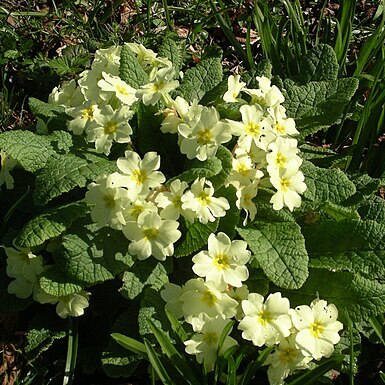Annual or perennial herbs, or rarely shrubs; stems erect or prostrate and rooting at the nodes. Leaves basal or cauline, alternate, opposite or verticillate, simple or lobed, entire or dentate; stipules absent. Flowers axillary and solitary, racemose, verticillate or paniculate, hermaphrodite, regular, sometimes heterostylous. Calyx gamosepalous, free or rarely adnate to the ovary, 4–9-partite, usually persistent. Corolla gamopetalous, rotate, hypocrateriform or campanulate, with a very short to long tube and 4–9-partite limb, or corolla rarely absent. Stamens equal in number to and inserted opposite the corolla-lobes. Ovary superior or rarely half inferior, 1-locular; ovules 2–3 or usually many on a free central placenta. Fruit a capsule, valvate or circumscissile or rarely indehiscent. Seeds small, 1, few or usually numerous, often angular
Herbs perennial or annual, rarely suffruticose. Leaves alternate, opposite, or whorled, often all basal, simple, entire to lobed. Flowers solitary or in panicles, racemes, or umbels, usually with bracts, perfect, (4-or)5(--9)-merous, often heterostylous (Primula). Calyx persistent. Corolla gamopetalous, actinomorphic, rarely absent (Glaux). Stamens as many as and opposite corolla lobes, ± epipetalous, occasionally with scalelike staminodes. Filaments free or connate into a tube at base. Ovary superior, rarely semi-inferior (Samolus), unilocular; placentation free central; style simple; stigma inconspicuous, capitate. Fruit a capsule, dehiscing by valves, rarely circumscissile or indehiscent. Seeds many or few; embryo small, straight, surrounded by endosperm.
Flowers actinomorphic or very rarely zygomorphic, hermaphrodite, often heterostylous, solitary or in racemose, spicate, paniculate, umbellate or verticillate inflorescences
Leaves mostly basal, rarely cauline, alternate, opposite or verticillate, simple or lobate, often dentate; stipules absent
Stamens equalling corolla–lobes, usually adnate to the corolla, oppositipetalous, sometimes alternating with staminodes
Ovary superior, rarely semi-inferior, 1-celled with a free basal placenta and numerous, or very rarely few ovules
Ovary superior or rarely semi–inferior, unilocular; placentation free–central; ovules 2–3 or more, usually many
Leaves exstipulate, basal or cauline, alternate, opposite or verticillate, simple or lobed, entire or dentate
Corolla gamopetalous, rotate to campa–nulate with a very short to long tube and 4–9–lobed limb, rarely absent
Calyx gamosepalous, free or rarely partially adnate to the ovary, (4)5(9)–partite, usually persistent
Annual or perennial herbs or rarely shrubs; stems erect or procumbent and rooting at the nodes
Annual or perennial herbs or rarely shrubs; stems erect or prostrate and rooting at nodes
Stamens inserted on the corolla, the same number as and opposite to the lobes
Fruit a capsule with valvate or circumscissile dehiscence, rarely indehiscent
Corolla hypocrateriform, campanulate or tubular, lobes 5, imbricate
Seeds angular with a small straight embryo in copious endosperm
Flowers solitary to paniculate, actinomorphic, hermaphrodite
Fruit a capsule, many-seeded or very rarely 1-seeded
Seeds few to numerous, often angular
Calyx persistent, often leafy
Pending.

